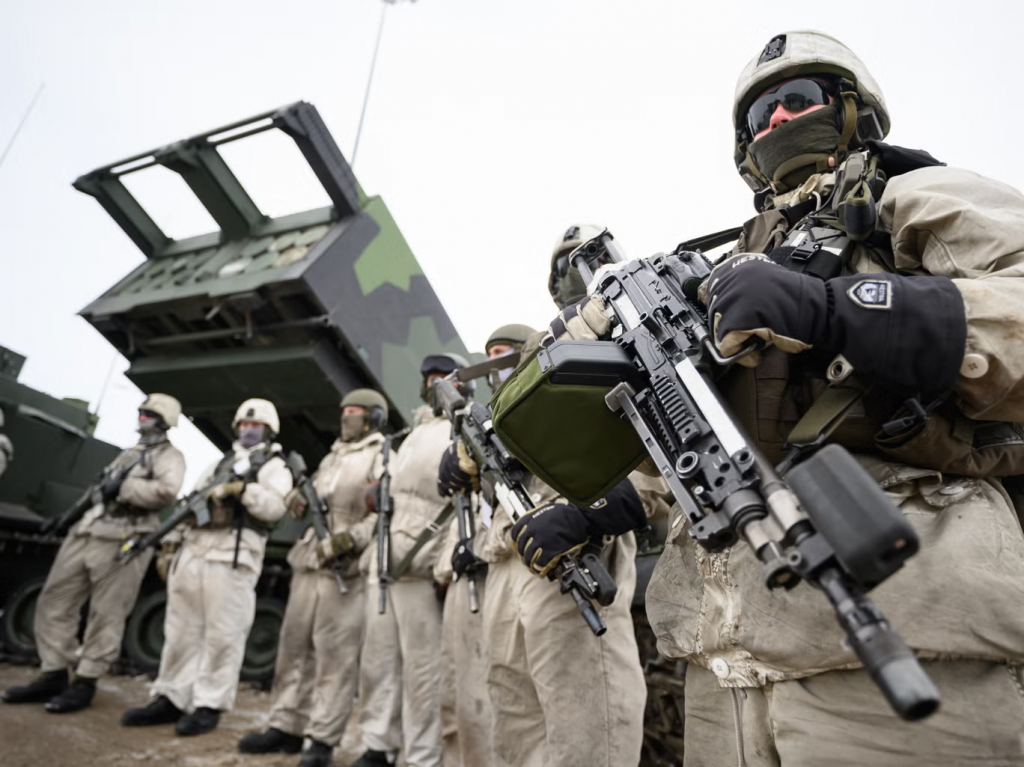Bulldozers and diggers are constructing field defenses in rural areas of Poland, Finland, and the Baltic States, located less than 1,500 kilometers (900 miles) from London.
Tank traps, pillboxes, and anti-tank trenches are being built, while the establishment of minefields, including controversial anti-personnel minefields, is actively under discussion in these countries.
In response to Russia’s growing threat, Poland is investing at least €2.5 billion (£2.1 billion) in border defense measures, which include building a sky shield system similar to Israel’s “Iron Dome.”
“It is essential to create an iron dome against missiles and drones,” said Poland’s Prime Minister, Donald Tusk, at a May conference with European leaders in Warsaw.
“Europe has every reason to have its own missile defense shield,” he said, confirming that the project is already underway.
He added that it doesn’t take much imagination to recognize that Europe, like Israel, is facing significant threats. To support this defense initiative, Poland’s strategy includes early threat detection and monitoring systems, alongside physical anti-tank barriers, bunkers, and AI-powered anti-drone technology.
Poland is set to position itself as a European defense leader with what could become the largest national security expenditure in the country’s post-war history.
Poland currently allocates €37 billion (£30 billion) to defense, accounting for 4.7% of its GDP, with further increases under consideration.
Meanwhile, the Baltic republics are investing hundreds of millions of euros to strengthen their defense lines in response to the “hybrid war” tactics being employed across multiple fronts in the region.
This is part of a broader initiative being planned by NATO members Estonia, Latvia, and Lithuania, with construction set to begin in 2025.
Over €1 billion is being quickly invested in the construction of new ammunition facilities across northern Europe, particularly for 155mm artillery rounds, which Ukraine is firing at unprecedented rates not seen since World War II.
Meanwhile, how is the United Kingdom responding to the escalating global threat? The nation is discarding ships, drones, and helicopters worth £500 million.
The United Kingdom will next evaluate its strategic defenses to determine its future course of action. The Strategic Defense Review (SDR) is expected to be released in late February 2025.
If we’re fortunate, the release of the Strategic Defense Review (SDR) may be delayed, despite Defense Secretary John Healey’s statement last week that the cuts are happening amid “war in Europe, growing Russian aggression, and conflict in the Middle East.” Some suggest that Whitehall bureaucracy could push the review’s release until the summer.
Meanwhile, time is running out. The liberal-democratic governments of northern Europe, renowned for their services and quality of life, agree that if Ukraine loses, the consequences could be dire for the region.
If Ukraine loses its war against Russia, Russia would likely feel emboldened to launch a military campaign against Finland, Poland, or the Baltic States.

Many analysts agree that this could happen within the next three to five years. From a defense strategy perspective, that is essentially tomorrow.
A fighter plane takes between 28 and 30 months to be purchased and delivered, a tank takes 18 to 24 months, and a frigate requires 30 months, even when production is at full capacity.
In addition to the current events in Western Europe, defense spending is on the rise. By 2027, French defense spending is expected to surpass that of the UK on a like-for-like basis, following an increase over the previous eight years.
Two years ago, the Netherlands reversed decades of defense budget cuts, and within five years, it plans to triple its defense spending.
The defense budgets of Sweden, Norway, and Denmark are also rising, often with double-digit increases each year.
Additionally, the European defense powerhouse has awakened. Since Russia’s 2014 invasion of Crimea, Germany—one of the first countries to significantly reduce defense spending during the Cold War—has raised its military budget by two-thirds.
Importantly, the 2022 invasion of Ukraine marked a Zeitenwende (or “turning point”), with Chancellor Olaf Scholz pledging an immediate €100 billion investment to address munitions and equipment shortages.
Since then, Berlin has spent over €60 billion on ammunition and missiles since February 2022, and an additional €30–40 billion on F-35A fighters and other weapons provided by the US.
In Eastern Europe, defense is seen as an absolute necessity rather than a “nice-to-have” in these countries.
Over the past five years, many nations’ defense budgets have increased or even tripled. So, why does the UK now appear more like a laggard than a leader in Europe?

One of the main reasons is what I call the “1,700km duvet.” Russia would need to travel through Finland and the Baltic nations before reaching the UK, providing a natural buffer.
The Baltic Sea, along with Germany, Sweden, Denmark, and Norway, forms a strategic barrier before Russia can navigate the North Sea to reach the UK.
In response to a question about the potential for a missile strike on the United Kingdom, former Defense Secretary Grant Shapps joked that NATO members, positioned between the UK and Russia, would handle any such threats. His comment playfully referenced the idea of the “1,700km duvet” still providing a protective barrier for the UK.
But the threat is growing nearer. Concerns about Russian interference intensified this week following the damage to underwater internet cables in the Baltic Sea.
Western intelligence agencies suspect Russia was behind the fires at shipping terminals in Britain and Germany earlier this summer. Additionally, there are reports of potential Russian plans to test security systems and deploy incendiary devices on cargo flights across Europe.
Many now fear that the UK could soon face power outages due to unexplained failures of wind farm cables, or disruptions to internet services if the telecom infrastructure is compromised.

In reality, the UK is vulnerable to many modern forms of attack. At a recent conference in Berlin, Admiral Sir Tony Radakin, the head of the defense staff, openly acknowledged this vulnerability. He stressed the importance of learning from the Nordic and Baltic nations, urging the UK to bolster its civil and military preparedness in the face of potential conflict.
The Royal Navy is unable to deploy an aircraft carrier group without relying on US and allied ships and planes, despite any bold rhetoric.
The Army is critically understocked, with enough ammunition for only a month of combat, and is incapable of mobilizing a full division of 15,000 troops from its 70,000-strong force.
Of the more than 100 Typhoons in the RAF, only about two dozen are ready for combat.
While the defense secretary is right to stress that improving spending efficiency is as crucial as increasing funding, money still plays a vital role.
The UK cannot afford to delay its response, citing economic constraints, if a NATO member invokes Article 5, which calls for collective defense.
Many analysts in the Nordic and Baltic regions believe this scenario could unfold within the next five years.





